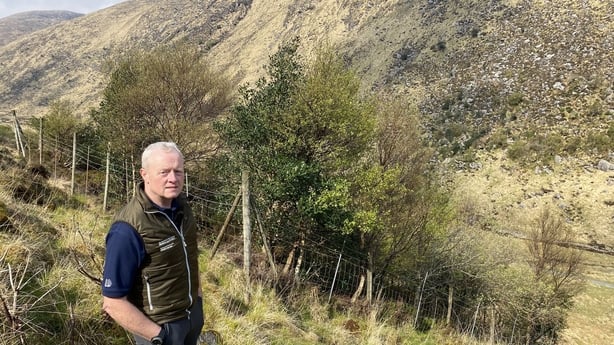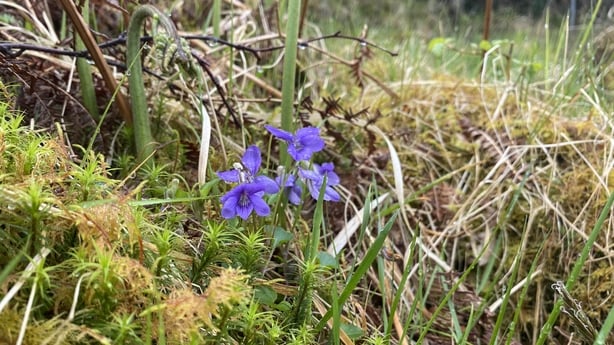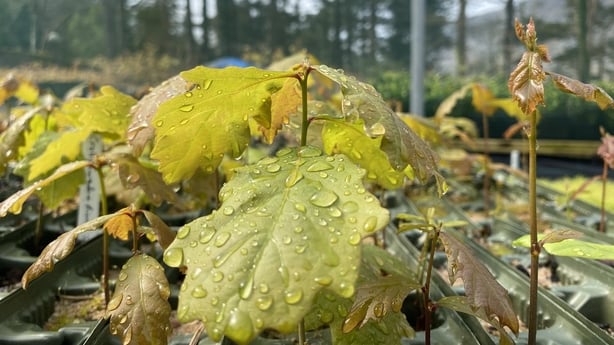The hills of Donegal are well loved and celebrated in song and story, but few realise that for most of history they looked very different to how they appear today.
Like much of Ireland, they were covered for thousands of years by native woodlands, and the current bare landscape is the result of human intervention.
Fragments of native woods survive around the county but many of those are threatened, degraded or diminished by invasive species and grazing, particularly by deer.
A new project in Glenveagh National Park is set to restore hundreds of hectares of native woodland returning those areas to how they were for most of history.
Glenveagh or Gleann Bheatha, meaning Glen of the Birches, was covered by native woodland until the middle of last century when fire along with pressure from grazing and human activity left the glen, at the centre of the park, mostly bare of trees.
Now it is the site for a project to restore native woodland to 600 hectares of land.

Sue Callaghan, manager for the Northern Division of the National Parks and Wildlife Service (NPWS) which covers counties Sligo and Donegal, said: “All the place names that you would have in this valley say, Doire Leathan, for instance, Doire,referring to Oak, so this whole valley of Gleann Bheatha would have been pretty much covered in old oak woodland mixed woodlands in the past, but now we’re confined to small pockets.”
The good news is that woodlands do return given the right conditions.
On the hillside in Glenveagh, NPWS District Conservation Officer Martin Toye points out a small area that was fenced off as a test plot about 30 years ago.
He said: “That’s all natural regeneration, they are all native species. You have oak, rowan in there. You have some willow in there.”
Protected from grazing by deer, seeds blown in from fragments of woodland further up the glen have grown into trees and the small area has transformed into a dense pocket forest
Fencing alone will not keep deer away, particularly as more areas are enclosed for woodland restoration.

The NPWS is implementing a deer management plan which includes culling and displacement to keep the animals away.
Mr Toye explained: “We keep pressure on the deer in those areas. which contribute to the regeneration of trees.
“So it’ll be culling methods during the open season. And the other method we use, displacement we call it.
“We just keep the pressure on the deer in the one area all the time that we make them that uncomfortable where they are, that they more out of that area of which again will enhance the chances of native woodland getting a grip.”
He added that the strategy emulates, in some ways, the presence of wolves by killing some deer and harrying the remaining animals.
In the areas outside the fenced off enclosure, Mr Toye’s colleague, conservation ranger Fildema Maher, is checking for flora which indicate the land is suitable for native woodland.

She said: “I’m seeing bluebells, wood sorrel, woodrush, tormentil which are really good indicator plants for woodland species for woodland.
“And considering this area was a woodland in the past, it’s actually a good sign to see these plants here because it means that this area will support woodland,”
Along the valley, trees are growing in steep gullies, too inaccessible for deer to reach.
The natural regeneration process is being aided by some planting of trees grown from seeds collected in the park.
The head gardener at Glenveagh National Park, Sean O’Gaothin, said it is important to use seeds collected locally.
He has recently published a book on Donegal’s native woodlands and said while the county is less forested than other places, “it just so happens that some of the finest examples of our ancient woodlands are in Donegal”.
“And that’s, you know, an accident of fate, you could say and a lot of these places like Glenveagh, like Ballyar woods, like Ardnamona, are actually nature reserves so they belong to the state now and are managed by National Parks and Wildlife Service. So we have a very rich heritage of native woodlands in the county in Donegal,” he said.

Mr O’Gaothin said he believes our native woodlands are vital. He said: “Our nature is fundamentally part of who we are.
“The flora and fauna that inhabits this island are the original inhabitants of this landscape of this land and we’re talking about you know, making them a priority now like a gift, you know, you’re actually making more space to for nature to recover.
“And we need our biodiversity because we need a healthy environment. We need a healthy farming environment. We need a healthy grazing environment. We need a healthy nature environment.”
His colleague Clare Bromley leads the education programme at Glenveagh.
She said the nature that people can see and experience at the park help people make that connection.
Ms Bromley said: “When you come into the woodlands here or when a project like this is going on, it’s a chance to really help them see science, you know, come to life.
“There’s an opportunity here for people to I suppose make connections between you know what’s going on and nature of the fact that we can do things to help.
“There is hope and we can change things better for the future. So I think it’s a fantastic place to come and use as an outdoor classroom.
“Because that thing biodiversity that we’re all talking about now and it is really important, but it’s very abstract thing and it’s a very big thing.”
Source link
 TG4 TV PC to TV
TG4 TV PC to TV
